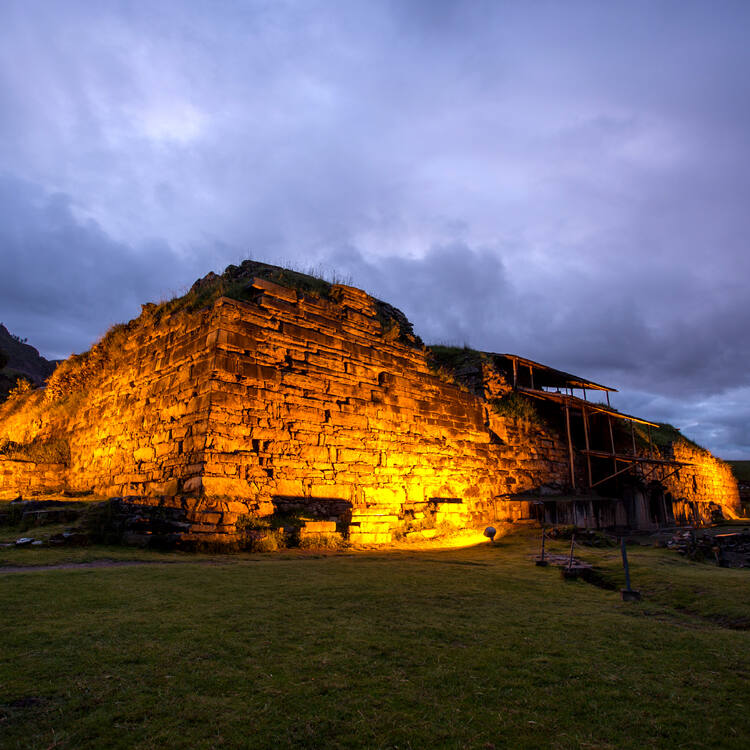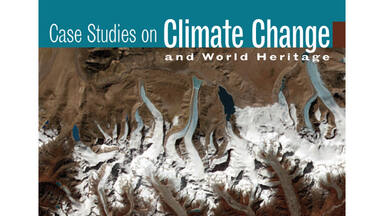Chavin (Archaeological Site)
Chavin (Archaeological Site)
The archaeological site of Chavin gave its name to the culture that developed between 1500 and 300 B.C. in this high valley of the Peruvian Andes. This former place of worship is one of the earliest and best-known pre-Columbian sites. Its appearance is striking, with the complex of terraces and squares, surrounded by structures of dressed stone, and the mainly zoomorphic ornamentation.
Description is available under license CC-BY-SA IGO 3.0
Site archéologique de Chavin
Ce site archéologique a donné son nom à la culture qui se développa entre 1500 et 300 av. J.-C. dans cette haute vallée des Andes péruviennes. L'architecture de cet ensemble de terrasses et de places entourées de constructions en pierres appareillées ainsi que son ornementation, en grande partie zoomorphique, donnent un aspect saisissant à cet ancien lieu de culte, l'un des sites précolombiens les plus anciennement connus et les plus célèbres.
Description is available under license CC-BY-SA IGO 3.0
موقع شافين الأثري
أعطى هذا الموقع الأثري اسمه للثقافة التي طوِّرت ما بين 1500 و300 ق.م. في هذا الوادي المرتفع في جبال الأندلز في البيرو. أما هندسة هذه المجموعة من المصطبات والساحات المسيّجة ببناء من الحجارة اضافة الى زخرفتها التي تتخذ أشكالاً حيوانية في قسم كبير منها، فتضفي طابعًا أخّاذًا لمكان العبادة هذا، الذي يُعتبر أحد المواقع الأثريّة التي تعود الى الفترة السابقة لاكتشاف كولومبوس، أي الأقدم والأكثر شهرة.
source: UNESCO/CPE
Description is available under license CC-BY-SA IGO 3.0
夏文考古遗址
夏文考古遗址的历史可以追溯到公元前1500年到公元前300年,它是在秘鲁安第斯山的高山峡谷中发展起来的一种文化。该遗迹是古代举行宗教仪式的场所,也是哥伦比亚发现新大陆以前出现的最负盛名之地。这里的斜坡和广场周围都是石头建筑,伴有大量兽形装饰物,景物别致多姿。
source: UNESCO/CPE
Description is available under license CC-BY-SA IGO 3.0
Археологические памятники центра древней индейской культуры Чавин-де-Уантар
Древний культовый комплекс Чавин-де-Уантар, руины которого обнаружены в высокогорной долине в Перуанских Андах, дал имя целой культуре, которая развивалась здесь в 1500-300 гг. до н.э. Это бывшее место поклонения является одним из древнейших и наиболее известных доколумбовых памятников. Поразителен его облик с комплексом террас и площадей, окруженных сооружениями из шлифованного камня с зооморфной орнаментацией.
source: UNESCO/CPE
Description is available under license CC-BY-SA IGO 3.0
Sitio arqueológico de Chavín
El sitio arqueológico de Chavín ha dado su nombre a la cultura que se desarrolló entre los años 1500 y 300 a.C. en el alto valle de los Andes peruanos en el que se encuentra. La arquitectura de este conjunto monumental de plazas y amplias terrazas rodeadas por construcciones de piedra labrada, así como su ornamentación en gran parte zoomorfa, dan un aspecto impresionante a este lugar de culto, que es uno de los sitios precolombinos más célebres y antiguos.
source: UNESCO/CPE
Description is available under license CC-BY-SA IGO 3.0
チャビン(古代遺跡)
source: NFUAJ
Archeologisch gebied van Chavín
Source: unesco.nl
Outstanding Universal Value
Brief Synthesis
The archaeological site of Chavin gave its name to the culture that developed between the 15th and the 5th century BC in this high valley of the Peruvian Andes, in the province of Huari, department of Ancash. Chavin was a ceremonial and pilgrimage centre for the Andean religious world and hosted people from different latitudes, distances and languages, becoming an important centre of ideological, cultural and religious convergence and dissemination around a cult spread over a wide territory of the Andes, as far as the north, central and south coasts, the northern highlands and high jungle of Peru.
Chavin is one of the earliest and best known pre-Columbian sites and represents the more important expression of the arts and decorative and construction techniques of its time. The ceremonial and cultural nature of the site is evident in its architectural, technological and symbolic creation, which is characterized by coated quarried stone buildings and artificial terraces around plazas, containing an internal gallery system with an intricate network of vents and drains unprecedented in South America. The buildings and plazas were decorated with lush anthropomorphic and zoomorphic symbolic iconography of extraordinary aesthetic synthesis, carved in bas-relief on tombstones, columns, beams and monolithic stone sculptures. The Chavin Lanzón, the Raimondi Stela, the Tello Obelisk, the Falconidae Portico, the Circular Plaza and the tenon heads, among others, are evidence of the outstanding and monumental Chavin lithic art. All of these features make the archaeological site a unique monument of universal significance.
Criterion (iii): The Chavin Archaeological Site, eponym of one of the ancient civilizations of South America, is an exceptional example of the architectural, technological and symbolic creations of the early pre-Columbian societies in the Peruvian Andes. Its appearance is breath-taking, with a series of terraces and squares, with a complex system of internal galleries, and decorated with anthropomorphic and zoomorphic iconographic elements of extraordinary beauty. It was an important centre of ideological, cultural and religious convergence and dissemination around a cult spread over a wide territory of the Andes.
Integrity
The boundaries of the inscribed property, 14.79 ha, contain all the elements, characteristics, and structural and symbolic key values of the architectural complex and of its historic evolution which convey its Outstanding Universal Value. Although the site has historically been affected by natural and anthropogenic phenomena, the wholeness of the complex made up by the buildings, platforms and plazas, the planimetry, its architectural design, the original shapes and materials of its different construction stages are still preserved; structures, galleries, plazas and architectural spaces still hold original elements and characteristics, including iconography, revealing its original use and function.
The wholeness and visual integrity of the Chavin Archaeological Site and its landscape has not undergone substantial changes, which is shown in the continuation of traditional agricultural activities in the surrounding areas. Environmental agents are the most relevant factor affecting the preservation of the integrity of the Chavin archaeological site, which have deteriorated its structures through time, including some landslides in the galleries, drains and internal vents. The most important are the floods caused by unexpected landslides and floods from glacial lakes (for example, the 1945 flood that partially buried the site), and earthquakes of high magnitude and intensity (such as the 1970 earthquake).
Authenticity
The conditions of authenticity of the Chavin Archaeological Site, including land planning and its architectural conception, shapes, materials and iconographic design have been maintained
The existing elements at the site are witnesses of the outstanding design, development and aesthetic lithic art synthesis of the tombstones, beams, columns, sculptures and others that remain in situ, and show its religious ideological connotations, the symbolism and ritual meaning of the compound, and the ceremonial use and function of spaces and architectural areas in particular. They also depict Chavin’s society and the process of historic evolution that reveal different construction stages and cultural contexts, because of the site’s continuous social functions that finally shaped its buildings. The material findings also reveal the function of the ceremonial centre as a place of pilgrimage by northern and central Peru populations in relation to cult clearly visible in its architectural iconography and in the religious paraphernalia found in the site. Archaeological investigations and conservation interventions carried out in the site have kept the spaces and structures of the ceremonial compound unchanged.
Protection and management requirements
Chavin Archaeological Site is properly protected by national law: the National Constitution (Art 36), Law Nº 6634 of June 13, 1929 that expressly stipulates the inalienable and indefeasible right of the Nation on all existing monuments prior to the Viceroyalty in the country and declares the Chavín Archaeological Site as a National Monument. Other legal tools for protection include Law Nº 28296, General Law for National Cultural Heritage which states the cultural heritage of the Nation is inalienable and indefeasible, and Law Nº 13442 which determines the creation of the Chavin Archaeological Site National Park and Centre of the Archaeological Tourism Zone in the province of Huari, department of Ancash.
After the flood that partially buried Chavin in 1945, protection, cleaning, preventive preservation, research and preparation works have been carried out with the participation of several institutions and the Ministry of Culture.
According to national regulation, the management and protection of the Chavin Archaeological Site is the responsibility of the Ministry of Culture on behalf of the Peruvian Government.
The Ministry of Culture had being developed a management plan where the necessary items to meet basic needs and develop permanent projects required for protecting, preserving and restoring the site under the framework of institutional operation schemes has being scheduled. In addition, research and preservation activities are supported by private institutions.
The Chavin Archaeological Site has permanent personnel; however, allocated resources are insufficient for the preservation works to be carried out at the site.

